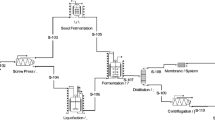Abstract
Successful deployment of a bioethanol process depends on the integration of technologies that can be economically commercialized. Pretreatment and fermentation operations of the traditional enzymatic bioethanol-production process constitute the largest portion of the capital and operating costs. Cost reduction in these areas, through improved reactions and reduced capital, will improve the economic feasibility of a large-scale plant.
A technoeconomic model was developed using the ASPEN PlusTN modeling software package. This model in cluded a two-stage pretreatment operation with a co-current first stage and countercurrent second stage, a lignin adsorption unit, and a cofermentation unit. Data from kinetic modeling of the pretreatment reactions, verified by bench-scale experiments, were used to create the ASPEN Plus base model. Results from the initial pretreatment and fermentation yields of the two-stage system correlated well to the performance targets established by the model. The ASPEN Plus model determined mass and energy-balance information, which was supplied, to an economic module to determine the required selling price of the ethanol. Several pretreatment process variables such as glucose yield, liquid: solid ratio, additional pretreatment stages, and lignin adsorption were varied to determine which parameters had the greatest effect on the process economics. Optimized values for these key variables became target values for the bench-scale research, either to achieve oridentify as potential obstacles in the future commercialization process. Results from this modeling and experimentation sequence have led to the design of an advanced two-stage engineering-scale reactor for a dilute-acid hydrolysis process.
Similar content being viewed by others
References
Elander, R., Ibsen, K., Hayward, T., Nagle, N., and Torget, R. (1997), in Making a Business in Biomass from Energy, Environment, Chemicals, Fiber and Materials, vol. 2, Overend, R. P. and Chornet, E., eds., Pergmon, Trowbridge, UK, pp. 1025–1034.
Harris, J. F., Baker, A. J., Connor, A. H., Jeffries, T. W., Minor, J. L., Pettersen, R. C., Scott, R. C., R. W., Springer, E. L., Wegner, T. H., and Zerbe, J. I. (1985), Two-Stage, Dilute Sulfuric Acid Hydrolysis of Wood: An Investigation of Fundamentals. General Technical Report FPL-45. U. S. Department of Agriculture Forest Products Laboratory, Madison, WI.
Wright, J., Bergeron, P., and Werdene, P. (1985), The Progressing Batch Hydrolysis Reactor. SERI/TP-232-2803. Solar Energy Research Institute, Golden, CO.
Torget, R. (1998), U. S. Patent (currently under application)
Torget, R. (1997), Process Economic Evaluation of the Total Hydrolysis Option for Producing Monomeric Sugars Using hardwood Sawdust for the NRÉL Bioconversion Process for Ethanol Production, P Level Milestone Report, National Renewable Energy Laboratory, Golden, CO.
Perez, J., Wilke, C. R., and Blanch, H. W. (1981), Enzymatic Hydrolysis of CornStover Process Development and Evaluation, Lawrence Berkeley National Laboratory, Berkeley, CA, Report #14223.
Gregg, D. J. and Saddler, J. N. (1997), Appl. Biochem. Biotechnol. 63/65, 609–623.
Keller, F. J. (1996), in Handbook on Bioethanol, Wyman, C. ed., Taylor & Francis, Washington DC, pp. 351–371.
Gregg, D. and Daddler, J. N. (1996), Appl. Biochem. Biotechnol. 57/58, 711–727.
Torget, R., Hatzis, C., Hayward, T. K., Hsu, T., and Philippidis, G. P. (1996), Appl. Biochem. Biotechnol. 57/58, 85–101.
Hatzis, C., Riley, C., and Philippidis, G. P. (1996), Appl. Biochem. Biotechnol. 57/58, 443–451.
Wooley, R. J. and Putsche, V. (1996), Development of an ASPEN Plus Physical Property Database for a Biofuels Components, National Renewable Energy Laboratory, Golden, CO, NREL/TP-425-20685.
Rivard, C. J., Engel, R. E., Hayward, T. K., Nagle, N. J., Hatzis, C., and Philippids, G. P. (1996), Appl. Biochem. Biotechnol. 57/58, 183–191.
Author information
Authors and Affiliations
Corresponding author
Rights and permissions
About this article
Cite this article
Nagle, N., Ibsen, K. & Jennings, E. A process economic approach to develop a dilute-acid cellulose hydrolysis process to produce ethanol from biomass. Appl Biochem Biotechnol 79, 595–607 (1999). https://doi.org/10.1385/ABAB:79:1-3:595
Issue Date:
DOI: https://doi.org/10.1385/ABAB:79:1-3:595




